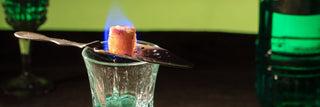| What is absinthe?

Known as "The Green Fairy" or "Green Devil", absinthe is a alcoholic beverage which is made from various herbs. Among them stands out the Artemisia absinthium , popularly known as the wormwood or holy herb, famous for its sedative properties, mainly due to thujone, a molecule present in very large quantities in wormwood and already used by the Greeks and Romans 400 years before Christ.
It has an anise flavor, with hints of bitterness and comes in various colours, green being the one that gives it its nickname and mystical appeal.
The explanation for the color of the drink is the time of exposure to light, since this influences the chlorophyll, which can go from emerald green to brown. It all depends on the aging process and reaction to light.
| The origin of absinthe
Its origin is not determined. Legend says that a French pharmacist, Dr. Pierre Ordinaire, exiled to Switzerland, he was the creator of a miraculous elixir for therapeutic use, the success was immediate. For a long time Absinthe was used only with medicinal purposes . The soldiers used to drink it at the front and then demanded it in bars, so it became a fairly common liquor in bars and taverns.

After the death of Dr. Pierre Ordinaire, the recipe was sold many times, before falling into the hands of the Dubied family, who marketed it and made it famous as the pleasure drink. Henry Louis Pernod, Dubied's son-in-law, was the first to relocate his factory to France as the initial factory located in Switzerland was unable to meet high French demand and import taxes. He then left Couvet to go and found his first factory in the Doubs in Pontarlier, and in 1805 he created Pernod&Fils.
| Is absinthe hallucinogenic?
Due to its high alcohol content (up to 89%), the absinthe it was one of the strongest drinks of the time and, according to the legends that surround it, it could cause hallucinations in its consumers . It was said that this made see green fairies and whatever you wanted to observe.

His influence was felt throughout Europe as a renewal of art in all its forms. Thanks to his fame, artists of the late 19th and early 20th centuries They also fell in love with the effects of this liquor, which inspired and transported them to the depths of their minds, making them create well-known works.
Hemingway, Picasso, Van Gogh, Oscar Wilde, Rimbaud, among others they are on the list of celebrities who tried absinthe.
"After the first drink you see things as you wish they were, after the second you see them as they are not, and at the end you see them as they really are, and that is the most horrible thing in the world," he wrote. Wilde in reference to the drink.
Until the middle of the 19th century it was reserved almost exclusively for the bourgeoisie. To popularize it and make it affordable, low-quality absinthes began to be made, based on alcohol or beet grains, or even potatoes, which were much cheaper than the alcohol used for wine.
| Controversy and ban
With the proliferation of low-quality absinthes, rumors began to grow that this drink caused various ailments.
After several studies, it was determined that the consumption of absinthe was harmful to health, a fact that ended up determining that from the year 1915 several countries prohibited its production and sale.
| absinthe returns
New studies show that thujone, one of the molecules in the wormwood plant, is not harmful. The perverse effects that were attributed to absinthe were due to its excessive consumption and its high degree of alcohol.
The new recipes also contain much less thujones and the name "absinthe" is reauthorized by the law of May 17, 2011. In this regard the Lehmann Thujone Delirium absinthe is the one with the highest content of thujones, within the legal limit, so it is the one that most closely resembles the original absinthes of yesteryear.
Absinthe is back in fashion in Europe and North America. Its mythology continues to have an aura of mystery, the collective fantasy has brought absinthe closer to drugs when reality is very different.
| The absinthe preparation ritual
If something has contributed to the rebirth of absinthe, it is its curious and spectacular preparation ritual. In the following video you can see the steps described above.
The steps to follow are those:
- First of all you must have a special spoon for absinthe (or failing that, a fork) that you will rest on a glass. With the purchase of any Lehmann absinthe we give you a free spoon.
- One or two lumps of sugar are deposited on the spoon.
- The absinthe is poured into the glass through the spoon so that the lumps are soaked in absinthe.
- Once we already have the desired amount of absinthe in the glass (about 60 ml) with a lighter, set the sugar cube on fire. The sugar begins to caramelize and falls to the bottom of the glass.
- After a few minutes, pour the remaining sugar from the spoon into the glass and mix. At this point it is also possible to add water to taste if you prefer to reduce the alcoholic strength of the absinthe.



